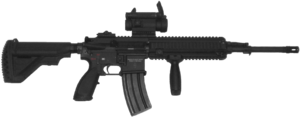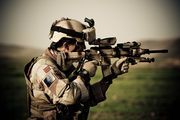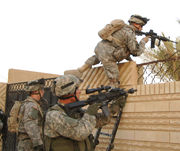Heckler & Koch HK416
| HK416 | |
|---|---|
 Norwegian Army Heckler & Koch HK416N with 419 mm (16.5 in) long barrel, an Aimpoint CompM4 red dot sight and a vertical foregrip. |
|
| Type | Assault Rifle |
| Place of origin | |
| Service history | |
| In service | 2005–present |
| Used by | See Users |
| Wars | Iraq War, War in Afghanistan |
| Production history | |
| Designer | Ernst Mauch |
| Manufacturer | Heckler & Koch |
| Produced | 2005–present |
| Variants | D10RS, D14.5RS, D16.5RS, D20RS, MR223, HK417 |
| Specifications | |
| Weight | D10RS: 3.02 kg (6.7 lb) D14.5RS: 3.490 kg (7.69 lb) D16.5RS: 3.560 kg (7.85 lb) D20RS: 3.855 kg (8.50 lb) |
| Length | D10RS: 797 mm (31.4 in) stock extended / 701 mm (27.6 in) stock collapsed D14.5RS: 900 mm (35.4 in) stock extended / 804 mm (31.7 in) stock collapsed D16.5RS: 951 mm (37.4 in) stock extended / 855 mm (33.7 in) stock collapsed D20RS: 1,037 mm (40.8 in) stock extended / 941 mm (37.0 in) stock collapsed |
| Barrel length | D10RS: 264 mm (10.4 in) D14.5RS: 368 mm (14.5 in) D16.5RS: 419 mm (16.5 in) D20RS: 505 mm (19.9 in) |
| Width | 78 mm (3.1 in) |
| Height | 240 mm (9.4 in) |
|
|
|
| Cartridge | 5.56x45mm NATO |
| Action | Gas-operated, rotating bolt |
| Rate of fire | 700-900 rounds/min (cyclic) |
| Muzzle velocity | Varies by barrel length and type of round used. |
| Feed system | 20, 30-round STANAG magazine or 100-round Beta C-Mag |
| Sights | Rear rotary diopter sight and front post, Picatinny rail |
The HK416 is an assault rifle designed and manufactured by Heckler & Koch. It is a modified version of the American M4 carbine with many changes, most notably a new gas operating system from the G3. The weapon is originally an American design, that has been modified by a German company.
The US Army's Delta Force collaborated with the German arms maker to develop the new carbine. Delta replaced its M4s with the HK416 in 2004 after tests revealed that the piston operating system significantly reduces malfunctions while increasing the life of parts.[1]
The project was originally called the HK M4, but this was changed in response to a trademark infringement suit filed by Colt Defense. The weapon has been tested by the United States military and is in use with some law enforcement agencies and special operations units. It has been adopted as the standard rifle in two NATO nations as well. A modified variant is undergoing testing by the United States Marine Corps as the M27 Infantry Automatic Rifle.
Contents |
Design details

The HK416 uses a proprietary gas system derived from the HK G36, replacing the direct impingement gas system used by the standard M16/M4.[2] The HK system uses a short-stroke piston driving an operating rod to force the bolt carrier to the rear. This design prevents combustion gases from entering the weapon’s interior, a shortcoming with direct impingement systems.[3] The reduction in heat and fouling of the bolt carrier group increases the reliability of the weapon and extends the interval between stoppages. It also reduces operator cleaning time and stress on critical components. The SA80 bull-pup assault rifle used this system long before the HK G36 was developed. According to H&K "experience that Heckler & Koch gained during its highly successful 'midlife improvement programme' for the British Army SA80 assault rifle, have now borne fruit in the HK416.".[4]
The HK416 is equipped with a proprietary accessory rail forearm with MIL-STD-1913 rails on all four sides. This allows most current accessories, used on M4/M16-type weapons, to be fitted to the HK416. The HK416 rail forearm can be installed and removed without tools by using the bolt locking lug as the screwdriver. The rail forearm is 'free-floating' and does not contact the barrel, improving accuracy.
The HK416 has an adjustable multi position telescopic butt stock, offering 6 different lengths of pull. The shoulder pad can be either convex or concave and the stock features a storage space for maintenance accessories, spare electrical batteries or other small kit items.
The trigger pull is 34 N (7.6 lbf). The empty weight of a HK416 box magazine is 250 g (8.82 oz).
The HK416's barrel is cold hammer-forged with a 20,000 round service life and features a 6 grooves 178 mm (7 in) right hand twist. The cold hammer-forging process provides a stronger barrel for greater safety in case of an obstructed bore or for extended firing sessions. This includes "OTB" (Over-the-beach) capability; the HK416 can be safely fired after being submerged in water and not completely drained.[5]
Evaluation
In July 2007, the US Army announced a limited competition between the M4 carbine, FN SCAR, HK416, XCR, and the previously-shelved HK XM8. Ten examples of each of the four competitors were involved. Each weapon was fired for 60,000 rounds in an "extreme dust environment." The purpose of the shoot-off was for assessing future needs, not to select a replacement for the M4.[6][7] The XM8 scored the best, with only 127 stoppages in 60,000 total rounds, the FN SCAR Light had 226 stoppages, while the HK416 had 233 stoppages. The M4 carbine scored "significantly worse" than the rest of the field with 882 stoppages.

The HK416 was one of the weapons displayed to U.S. Army officials during an invitation-only Industry Day on November 13, 2008. The goal of the Industry Day was to review current carbine technology prior to writing formal requirements for a future replacement for the M4 carbine.[8][9]
In December 2009, a modified version of the HK416 was selected for the final testing in the Infantry Automatic Rifle program, designed to partially replace the M249 light machine gun at the squad level for the United States Marine Corps.[10] It beat the three other finalists by FN Herstal and Colt Defense. In July 2010, the HK416IAR was designated as the M27, and 450 were procured for additional testing.[11]
The Norwegian Army made an extensive evaluation before selecting the HK416 as its new primary firearm. Since the first units began to use it in 2007, some minor problems have been discovered: The valve regulating the pressure for the gas-piston is easily obstructed if not cleaned properly over time, disabling the rifles ability as a semi-automatic weapon. The selective fire trigger-mechanism has shown weaknesses that in some cases makes the weapon unintentionally fire at fully automatic even if set to fire at semi-automatic. The bolt when locked in the back position, can unintentionally load a cartridge when the buttstock is submitted to any kind of force. All these problems are scheduled to be fixed in future batches.
Variants
The HK416 is currently available in four different barrel lengths: the D10RS model with a 264 mm (10.4 in) barrel, the 368 mm (14.5 in) barrel length D14.5RS, the D16.5RS fitted with a 419 mm (16.5 in) and the 505 mm (19.9 in) length barrel of the D20RS. The HK417 is a larger version of the HK416 chambered for the full-size 7.62x51mm NATO rifle cartridge. Civilian variants of the HK416 and HK417 were announced in 2007, named MR223 and MR308.[12] Both are semi-automatic rifles with several 'sporterized' features. At the 2009 SHOT Show, these two firearms were introduced to the American civilian market renamed respectively MR556 and MR762.[13]
Differences from the M4
The HK416 is a highly modified variant of the American carbine, the M4. It includes international symbols for Safe, Semi-Automatic, and Fully automatic, a redesigned retractable stock which allows the user to rotate the butt plate, a new pistol grip designed by H&K, made to more ergonomically fit the hand and, attached to the rifle is a new single-piece hand guard with a free floating RIS system, used for mounting accessories. The most notable internal difference is the short stroke gas piston system, derived from the HK G36. To compensate for increased pressure due to the new gas system, a thicker barrel was also integrated. Finally, the HK416 includes a folding front sight, and a rear sight similar in design to the G3. The HK416 system is offered as an upper receiver, separate from the rest of the rifle, as a replacement to the standard issue M4 upper receiver. It can be attached to any existing AR15 family rifles, giving them the new gas system, the new hand guard, and sights, while retaining the original lower receiver. The Heckler & Koch 416 can also be purchased as a fully assembled, stand alone carbine.
Users
| Country | Organization name | Model | Quantity | Date |
|---|---|---|---|---|
| Special Operations Command[14] | _ | Small numbers for field testing. | _ | |
| French Air Force special forces[15] | _ | _ | _ | |
| German Special Forces Command (Kommando Spezialkräfte, KSK) of the German Army[16] | _ | _ | _ | |
| Detasemen Jala Mengkara (Denjaka) counter-terrorism group of the Indonesian Navy[17] | _ | _ | _ | |
| Army Ranger Wing[18] | _ | _ | _ | |
| Italian special forces[16] | _ | _ | _ | |
| Japan Maritime Self-Defense Force[19] | _ | _ | _ | |
| Pasukan Khas Laut (PASKAL) Counter-Terrorism unit of the Royal Malaysian Navy[20][21][22] | _ | 180 | 2010 | |
| Netherlands special forces[16] Korps Commandotroepen[23][24] | D10RS D145RS |
_ | July 2010 | |
| Norwegian Armed Forces[25], replacing the AG-3 which has been in use since 1967[26] | HK416N | 24,000 | 2010 | |
| GROM[27] | _ | _ | _ | |
| 5th Special forces regiment[28] | _ | _ | 2010 | |
| 1st Special Forces Operational Detachment-Delta (Delta Force) of the United States Army[29] | _ | _ | _ | |
| Asymmetric Warfare Group of the United States Army[30] | _ | _ | _ | |
| Special Weapons and Tactics (SWAT) of the United States Capitol Police[31] | _ | _ | _ | |
| NASA ERT[32] | _ | _ | _ | |
| US Marine Corps [33] | M27 IAR | Small numbers for field testing | _ |
References
- ↑ Newer carbines outperform M4 in dust test
- ↑ "Heckler-Koch.de - HK416". http://www.heckler-koch.de/HKWebText/detailProd/1928/337/4/19. Retrieved 2010-02-12.
- ↑ Animation of the gas system of the HK416
- ↑ "Heckler-Koch.de - HK416". http://www.heckler-koch.de/HKWebText/detailProd/1928/337/4/19. Retrieved 2010-02-12.
- ↑ "HKD-USA.com - HK416". http://www.hkd-usa.com/HKWebText/detailProd/1928/337/4/19. Retrieved 2007-09-22.
- ↑ Lowe, Christian (2007-06-27). "Army Agrees to M4 Sand Test Shoot-Off". Military.Com. http://www.military.com/NewsContent/0,13319,143790,00.html?ESRC=army-a.nl. Retrieved 2007-09-22.
- ↑ "M4 to face new rifles in dust-chamber test". http://www.armytimes.com/news/2007/07/army_rifle_070715/. Retrieved 2007-09-22.
- ↑ http://www.armytimes.com/news/2008/11/army_carbineday_112308w/
- ↑ http://www.militarytimes.com/multimedia/photo/replacing_the_m4/
- ↑ Lamothe, Dan (December 14, 2009). "Frontrunner chosen in IAR contest". Marine Corps Times. pp. 20.
- ↑ Lamothe, Dan (July 2, 2010). "Conway eyes additional testing for auto-rifle". Marine Corps Times. http://www.marinecorpstimes.com/news/2010/07/marine_IAR_070110w/. Retrieved 2 July 2010.
- ↑ HK MR-223 and MR-308 rifles for the European market
- ↑ HK MR-556 and MR-762 rifles for the American market
- ↑ "Aus Tender - HK416 Contract Notice". 2010-07-30.
- ↑ "L'armée de l'air abandonne (partiellement) le fusil FAMAS". 2009-06-06. http://www.lepoint.fr/actualites-monde/2009-03-06/l-armee-de-l-air-abandonne-partiellement-le-fusil-famas/1648/0/323185.
- ↑ 16.0 16.1 16.2 Kemp, Ian (2009). "A New 5.56mm Generation or a Changing of the Guard?". http://asianmilitaryreview.com - Asian Military Review. http://www.asianmilitaryreview.com/upload/200906161450071.pdf. Retrieved 2010-04-18.
- ↑ HK416, The New Denjaka Weapon
- ↑ Tactical Weapons, May 2010 Issue. Guns of the Elite: Multi-Mission Warriors, page 92.
- ↑ "「自動小銃固定用金具の製作以下3件」の契約希望者募集要項". 2009-04-22. http://www.mod.go.jp/msdf/bukei/y0/nyuusatsu/K-21-0075-4050.pdf.
- ↑ Abas, Marhalim (2009-05-06). "Tender of HK416". Malaysian Defence. http://www.malaysiandefence.com/?p=590. Retrieved 2010-02-01.
- ↑ Abas, Marhalim (2010-04-23). "DSA 2010 Part III". Malaysian Defence. http://www.malaysiandefence.com/?m=20100423. Retrieved 2010-05-25.
- ↑ Abas, Marhalim (2010-04-23). "DSA 2010: The biggest security and defence show in Asia". Malay Mail Online. http://www.mmail.com.my/content/35151-dsa-2010-biggest-security-and-defence-show-asia. Retrieved 2010-05-25.
- ↑ KCT operator krijgt nieuw persoonlijk wapen, Dutch Defence Press, 16 July 2010 (Dutch)
- ↑ HK416 nieuwe wapen commando’s, Dutch Ministry of Defence, 16 July 2010
- ↑ Watne, Monique (008-09-22). "Nye angrepsrifler i Afghanistan". Mil.no. http://www.mil.no/start/aktuelt/article.jhtml?articleID=166327. Retrieved 2010-02-04.
- ↑ "Norway selects the HK416". http://www.hkd-usa.com/HKWebNews/byItemID///13//3/15. Retrieved 2007-09-22.
- ↑ Wilk (REMOV), Remigiusz. "Nowe gromy GROM". http://www.altair.com.pl/cz-art-1660.
- ↑ "Profesionál, 4. marca 2010". http://www.mosr.sk/17169/profesional-4-marca-2010.php.
- ↑ Cox, Matthew (March 1, 2007). "Better than M4, but you can't have one". Army Times. http://www.armytimes.com/news/2007/02/atCarbine070219/. Retrieved 2007-03-15.
- ↑ Army takes HK416s from special unit - Army News, opinions, editorials, news from Iraq, photos, reports - Army Times
- ↑ HK Pro article
- ↑ Andre M. Dall'au. "NASA ERT: Spaceport Protectors". Tactical Life. http://www.tactical-life.com/online/tactical-weapons/nasa-ert-spaceport-protectors/. Retrieved 2010-05-23.
- ↑ http://www.defenseindustrydaily.com/IAR-What-IAR-The-USMCs-SAW-Substitution-05240
External links
- Official page
- HK416 development story from Larry Vickers
- Modern Firearms page
- Heckler and Koch HK416 Enhanced Carbine
- Military.com article on HK416
- Aftenposten: Arvtageren til AG-3 (Norwegian report on the army's new standard rifle) (Norwegian)
- Mil. no (Norwegian Armed Forces official website): Adjø til AG-3 ("Goodbye to AG-3", a short presentation of the new HK416) (Norwegian)
- Mil. no (Månedens gadget: Gadget of the month) (Norwegian)
- Heckler & Koch DE article on the Norweigian HK416
- The USA's M4 Carbine Controversy, includes the HK416
|
|||||||||||||||||||||||||||||||||||||||||||
|
||||||||
|
|||||||
|
|||||||||||||||||||||||||||||||||||||||